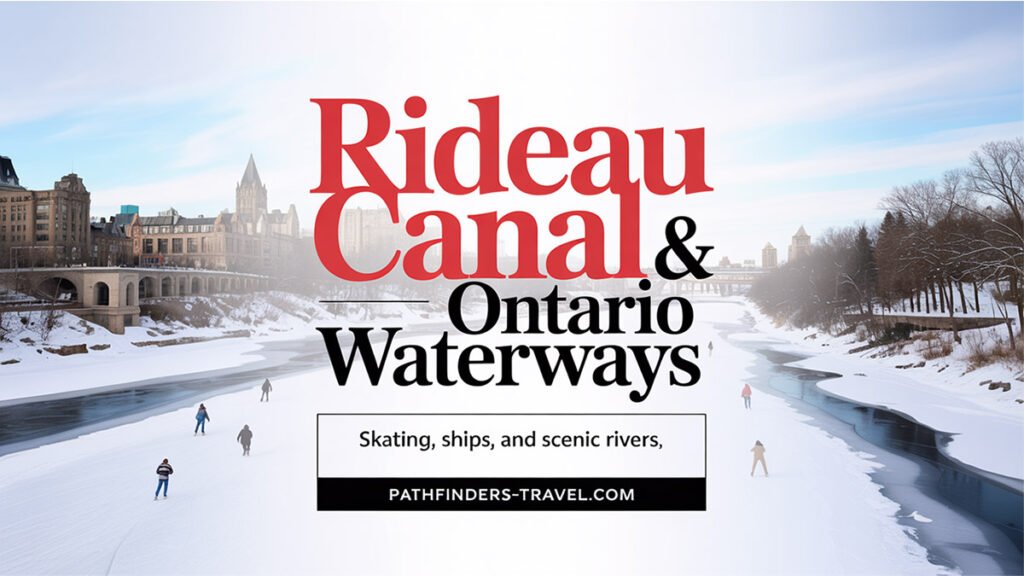Estimated reading time: 15 minutes
Key Takeaways
- The Welland Canal connects Lake Ontario and Lake Erie, with Lock 3 offering exceptional viewing opportunities for ships passing through.
- The Rideau Canal in Ottawa transforms seasonally, offering boating in summer and becoming the world’s largest natural skating rink in winter.
- The St. Lawrence River has played a critical role in Canadian history, from indigenous transportation routes to modern shipping and tourism.
- Ontario’s waterways combine engineering achievements, historical significance, and recreational opportunities for visitors throughout the year.
- Each waterway offers unique visitor experiences, from watching massive ships navigate locks to skating on frozen canals in winter.
Table of Contents
- Introduction
- The Welland Canal – Engineering Marvel and Tourist Spot
- The Rideau Canal – A Dual-Season Destination in Ottawa
- The St. Lawrence River – A Living History
- Tips for Visitors
- Frequently Asked Questions about Ontario’s Man-Made Waterways
- Conclusion
Introduction
Ontario’s landscape tells a story shaped by water. From the thundering power of Niagara Falls to the tranquil bays along Georgian Bay, water has carved the province’s geography and guided its development for millennia. Among Ontario’s most impressive water features is the Rideau Canal winter skating rink, a seasonal transformation that draws visitors from around the world. But this iconic skating destination is just one facet of Ontario’s remarkable waterways.
Three significant water routes have shaped Ontario’s development and continue to offer both practical transportation and recreational opportunities: the Welland Canal, the Rideau Canal, and the St. Lawrence River. Each represents a unique blend of natural beauty, engineering achievement, and historical significance that defines Ontario’s relationship with water.
These waterways aren’t merely navigational channels—they’re living museums of Canadian ingenuity, stages for outdoor recreation, and windows into the geological and human history that made Ontario what it is today. Whether you’re fascinated by massive ships rising through locks, looking for a scenic cycling route, or wanting to skate on the world’s largest natural ice rink, Ontario’s canals and rivers offer experiences found nowhere else.
Want to see this for yourself? Click here to watch the Wonders of Ontario in 4K UHD Resolution.
The Welland Canal – Engineering Guide and Visitor Experience
The Welland Canal stands as a testament to human ingenuity, connecting Lake Ontario and Lake Erie while bypassing the insurmountable barrier of Niagara Falls. Since its opening in 1829, this vital waterway has facilitated the movement of goods between the heart of North America and global markets, fueling Canada’s export economy and enabling the growth of communities along its shores. Niagara’s famous falls may draw more tourists, but the canal’s importance to commerce and transportation cannot be overstated.
A comprehensive guide to the Welland Canal reveals its impressive engineering. The canal stretches for 27 miles (43.5 kilometers), overcoming a height difference of approximately 326 feet (99.5 meters) between the two Great Lakes. What makes this system particularly remarkable is that it accomplishes this vertical lift without using pumps. Instead, the canal relies on gravity and the natural difference in water levels to raise and lower vessels through a series of eight locks.
Each lock acts as a water elevator. When a ship enters, massive gates close behind it, and water flows in from above, raising the vessel to the next level. The process is reversed when ships travel downward. This elegant, gravity-powered system has remained fundamentally unchanged since the canal’s construction, though the locks have been enlarged several times to accommodate larger vessels.
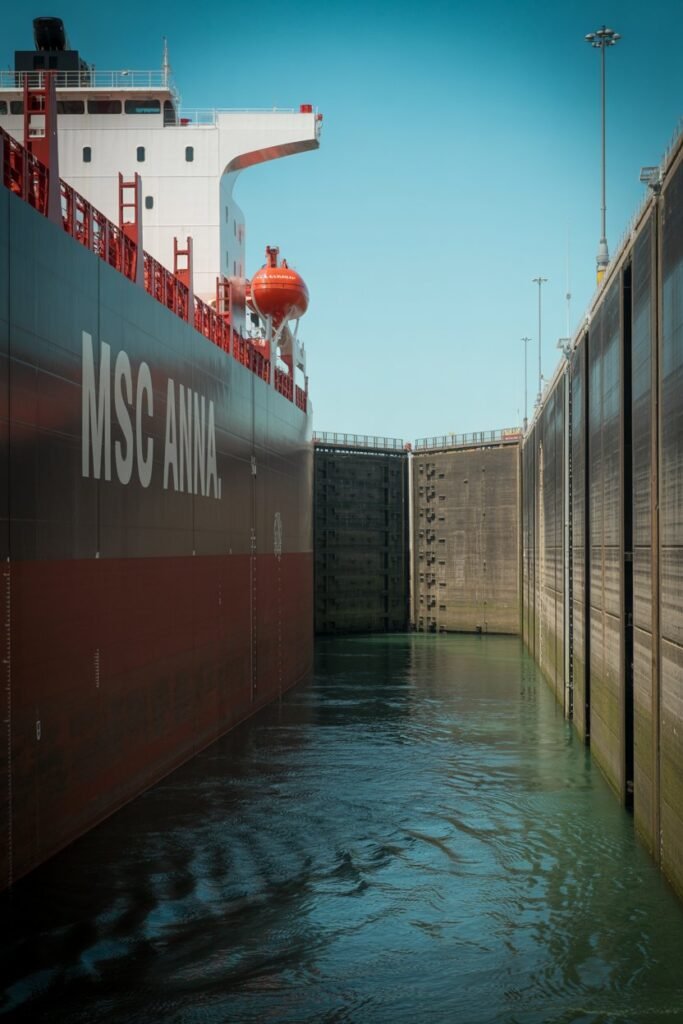
For visitors interested in watching ships at Welland Canal Lock 3, the experience offers a front-row seat to modern maritime commerce. Located in St. Catharines, Lock 3 has become the premier viewing location along the canal, featuring a visitor center with panoramic views. Here, you can stand at eye level with the bridge of passing lake freighters—massive vessels stretching up to 740 feet long and weighing 30,000 tons.
The Lock 3 Viewing Complex includes raised observation platforms, interpretive displays explaining the canal’s history and operation, and live ship-tracking information. Visitors can watch as these enormous vessels squeeze into the lock with just feet to spare on either side, then rise or descend 46 feet during the 45-minute locking process.
What makes Lock 3 particularly special is its accessibility. Unlike some other locks along the canal, Lock 3 offers ample parking, restroom facilities, and educational resources that make it ideal for families and casual visitors. The visitor center also provides schedules of expected ship traffic, helping you time your visit for maximum activity.
The canal operates 24 hours a day during the shipping season (typically late March through December), though summer offers the most pleasant viewing conditions. On busy days, you might see multiple ships—from massive Great Lakes freighters to international ocean-going vessels—passing through this vital marine highway.
The Rideau Canal – Ottawa Waterway for Summer and Winter Activities
The Rideau Canal stands as North America’s best-preserved 19th-century “slackwater” canal system. Constructed between 1826 and 1832 under the supervision of Lieutenant-Colonel John By, the canal was originally created as a military and commercial route to safeguard British interests after tensions with the United States. What makes this waterway particularly remarkable is that it remains operational along its original route with most original structures intact. [SOURCE]
In recognition of its historical importance and outstanding engineering, the Rideau Canal and associated fortifications earned designation as a UNESCO World Heritage Site in 2007. The canal stretches 202 kilometers (126 miles) from Ottawa to Kingston, connecting lakes and rivers through a series of 47 locks. Unlike many historic canals that were later modernized or abandoned, the Rideau maintains its 19th-century engineering character while serving modern recreational purposes. Kingston, at the canal’s southern terminus, offers additional historical attractions related to the waterway’s past.
Rideau Canal Ottawa Summer Activities and Routes
During the warmer months, the canal transforms into one of Ottawa’s premier recreational corridors. Rideau Canal Ottawa summer activities abound from May through October, when the waterway buzzes with pleasure craft of all sizes. Boating opportunities range from guided cruises to rentals of canoes, kayaks, and stand-up paddleboards.
The canal cuts directly through downtown Ottawa, offering a unique perspective on the city’s landmarks, including Parliament Hill. For those who prefer to stay on land, the canal’s edges feature well-maintained pathways ideal for walking, jogging, or cycling. These paths stretch for kilometers, connecting parks, gardens, and urban attractions.
What makes summer on the Rideau Canal particularly appealing is the blend of urban convenience and natural beauty. Within minutes, you can transition from the bustling heart of Canada’s capital to quiet stretches where the canal is lined with trees and wildlife. The pathways also connect to numerous waterfront parks where visitors can picnic, fish, or simply relax by the water.
Summer festivals often take advantage of the canal’s central location, with events like the Canadian Tulip Festival and Canada Day celebrations featuring the waterway as a backdrop. Outdoor patios and restaurants along the canal offer pleasant spots to enjoy the scenery while dining.
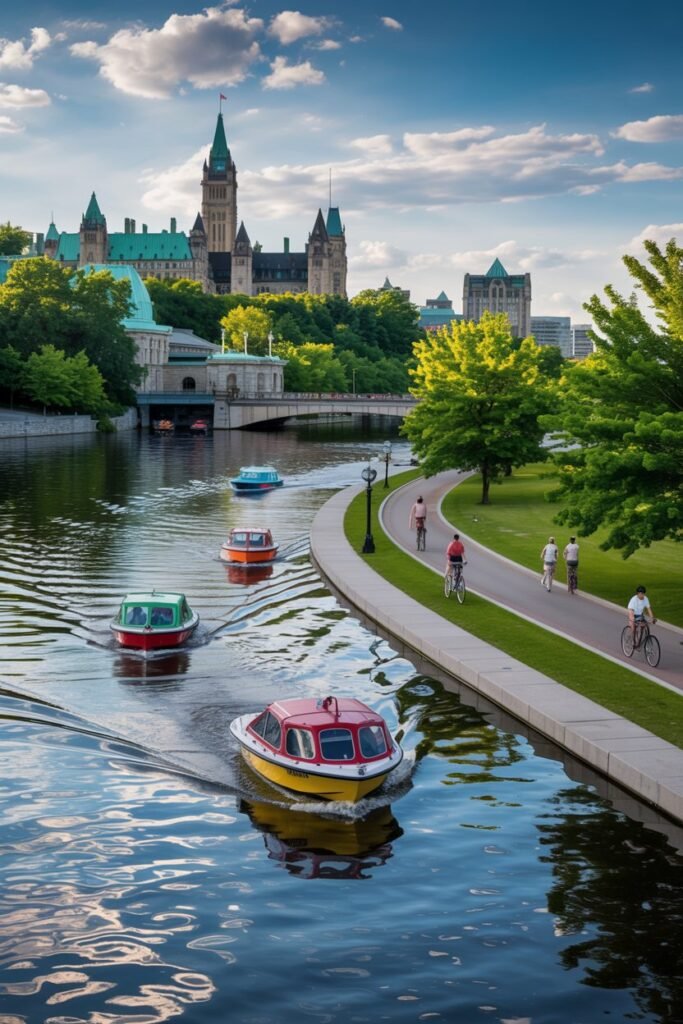
Rideau Canal Winter Skating Rink and Seasonal Events
Perhaps the most famous incarnation of this historic waterway is the Rideau Canal winter skating rink. When temperatures drop, usually from January through early March, a 7.8-kilometer stretch of the canal freezes solid, creating the world’s largest naturally frozen skating surface. [SOURCE]
This transformation is no small feat. Maintenance crews work throughout the winter to monitor ice thickness, clear snow, and ensure safe conditions. The result is a skating surface equivalent to 90 Olympic-sized hockey rinks laid end to end. The skating season typically lasts 4-8 weeks, depending on weather conditions.
What makes the Rideau Canal winter skating rink truly special is how it integrates into daily city life. Locals use it as a commuting route, gliding to work or school on skates. Tourists and residents alike enjoy the festive atmosphere, with rest areas, warming huts, and vendors selling hot drinks and traditional BeaverTails (fried pastries with various toppings) along the route.
Safety is taken seriously, with officials regularly testing ice thickness and posting clear condition reports daily. First-time visitors should note that the ice quality can vary depending on weather conditions and location along the canal. Skating is free, though skate rentals are available at various points if you don’t bring your own.
The winter skating season culminates with Winterlude, Ottawa’s February festival that celebrates winter with ice sculptures, performances, and activities centered around the frozen canal. This event draws thousands of visitors who come specifically to experience skating on this historic waterway.
History of the St. Lawrence River and Visitor Highlights
The history of the St. Lawrence River runs deep through Canada’s past, serving as a natural highway that shaped the nation’s development. For thousands of years before European contact, Indigenous peoples used this mighty river for transportation and trade, establishing communities along its fertile shores. When French explorers arrived in the 16th century, they quickly recognized the river’s strategic importance as a gateway to the continent’s interior. Ontario’s hidden gems often have connections to this historically significant waterway.
The river stretches approximately 1,200 kilometers (744 miles), connecting the Great Lakes with the Atlantic Ocean. This crucial position made it central to the fur trade, early settlement patterns, and later, industrial development. During conflicts between British and French colonial powers, and later between British Canada and the United States, control of the St. Lawrence was considered essential for military and commercial dominance in North America.
One of the most picturesque sections of the St. Lawrence River is the Thousand Islands region, where the river widens and flows around more than 1,800 islands scattered between Ontario and New York State. These islands played strategic roles during various conflicts, with forts and defensive positions established to control this vital waterway.
The islands range from tiny outcrops with a single tree to larger landmasses supporting communities and historic sites. Many feature impressive 19th-century mansions built by wealthy industrialists during America’s Gilded Age. Perhaps the most famous is Boldt Castle on Heart Island, constructed as a testament of love by hotel magnate George Boldt for his wife.
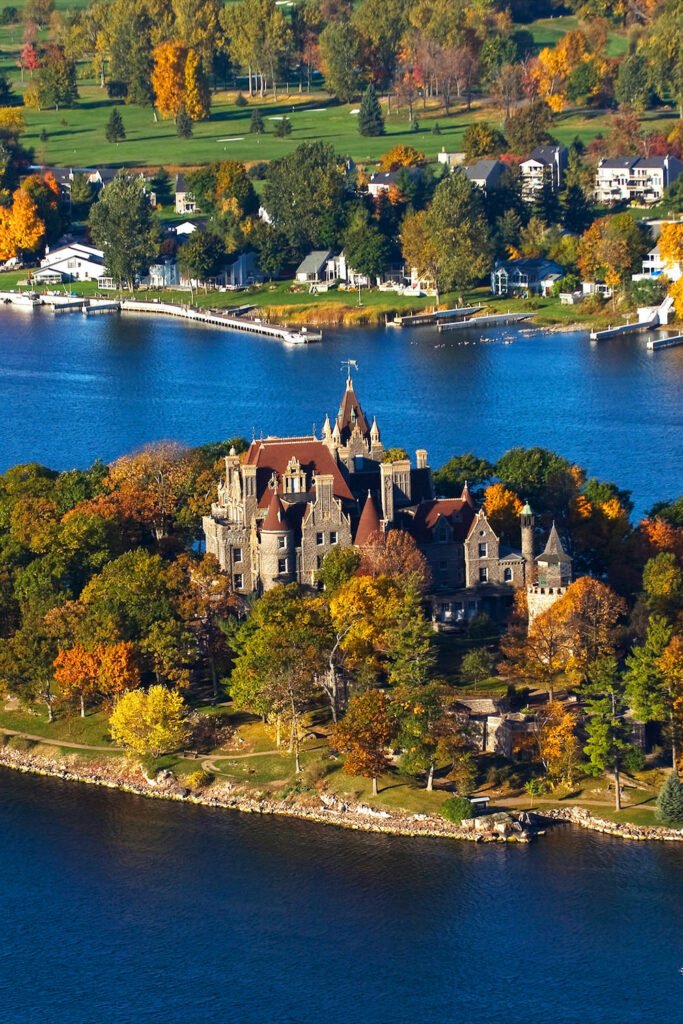
Today’s visitors to the St. Lawrence can experience this living history through various means. Boat tours operate from gateway communities like Gananoque, Brockville, and Kingston, allowing visitors to cruise among the islands while guides share stories of the region’s past. These tours often highlight how the river’s strategic importance shaped settlement patterns and defensive structures that can still be seen today.
Historical lighthouses dot the shoreline, many of which have been preserved and opened to visitors. These beacons once guided ships through the river’s challenging currents and narrow passages. Fort Henry in Kingston and other military installations showcase the river’s role in defending Canada’s borders.
Beyond its historical significance, the St. Lawrence River today supports diverse recreational activities. Fishing enthusiasts target walleye, northern pike, and bass in its waters. Diving expeditions explore numerous shipwrecks preserved in the cold, fresh water. Paddlers in kayaks and canoes explore quieter channels between islands, while sailors take advantage of the river’s reliable winds.
Unseen Canada often includes stretches of the St. Lawrence where natural beauty combines with historical significance. Conservation efforts have improved water quality in recent decades, helping to restore native fish populations and attracting wildlife watchers who come to spot bald eagles, osprey, and waterfowl along the shoreline.
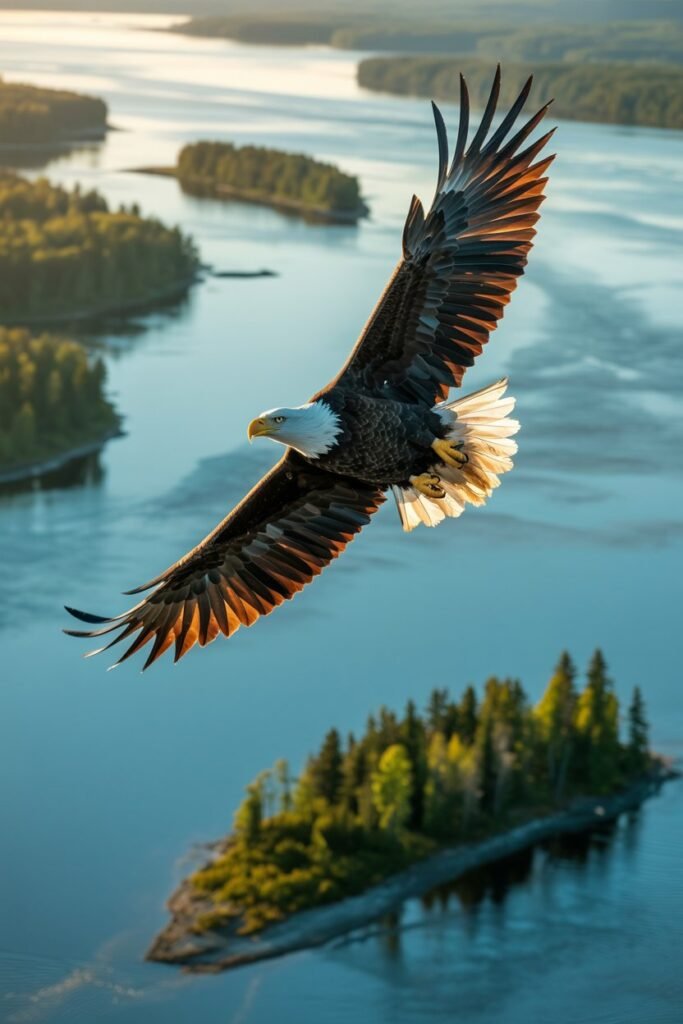
Tips for Visitors
Planning a visit to Ontario’s iconic waterways requires some strategic thinking to make the most of your experience. Here are some practical tips to enhance your exploration:
Best Times to Visit
Each waterway offers different experiences depending on the season:
- Welland Canal: The shipping season typically runs from late March to late December. Summer months (June-August) offer the most pleasant weather for watching ships, while spring and fall often see higher commercial traffic volume.
- Rideau Canal: For summer activities, plan your visit between May and October. For the winter skating experience, typically January through early March offers the best ice conditions, with February usually being the most reliable month.
- St. Lawrence River: Late spring through early fall (May-September) provides the best conditions for boat tours and outdoor activities. July and August offer the warmest water for swimming.
Recommended Tours
Guided experiences can significantly enhance your understanding and enjoyment:
- At the Welland Canal, the Lock 3 Museum and Viewing Complex offers excellent self-guided tours with informative displays about the canal’s operation and history.
- For the Rideau Canal, boat cruises operate from both Ottawa and Kingston ends, with options ranging from hour-long trips to multi-day excursions. In winter, guided skating tours can be arranged in Ottawa.
- The St. Lawrence River is best experienced through boat tours from Kingston, Gananoque, or Brockville, with options ranging from large tour boats to intimate zodiac adventures among the islands. Manitoulin Island, while not on the St. Lawrence, offers similar maritime experiences.
Safety Guidelines
Water safety should always be a priority:
- When visiting locks, stay behind all safety barriers and follow staff instructions. The powerful water movements and massive ships can create dangerous conditions.
- For boating activities, always wear proper life jackets, check weather forecasts before heading out, and be aware of shipping channels where large vessels have the right of way.
- During winter skating on the Rideau Canal, check daily ice condition reports, stay on cleared pathways, and be prepared for changing weather conditions. Helmets are recommended, especially for children.
- When hiking near waterways, stay on marked trails and be cautious on slippery surfaces near the water’s edge.
Practical Information
- Accessibility: Many viewing areas and visitor centers are wheelchair accessible, but trails and some historic sites may have limited accessibility. Check official websites for specific information.
- Photography: Early morning and late afternoon offer the best lighting for photographs of waterways. Polarizing filters can help reduce glare from water surfaces.
- Local Etiquette: When viewing active shipping operations, be respectful of working personnel and follow all posted guidelines. On shared pathways, cyclists should yield to pedestrians and announce when passing.
Frequently Asked Questions about Ontario’s Man-Made Waterways
When is the best season to enjoy Rideau Canal Ottawa summer activities or the winter skating rink?
For the Rideau Canal winter skating rink, the Skateway typically opens in mid to late January and remains available until early March, depending on the weather. In summer, recreational boating, walking, and cycling flourish from May through October. February is usually the most reliable month for skating, while July and August are peak months for boating.
How safe is skating on the Rideau Canal, and what precautions should I take?
Officials monitor ice thickness, maintain cleared paths, and post daily condition updates for safety. Stay within marked skating zones, wear a helmet—especially for children—and avoid edges or visible cracks. Dress warmly in layers, use protective gear for joints, and always follow posted advisories to ensure a safe experience.
What should I pack for a winter skating trip on the Rideau Canal?
Pack thermal layers, waterproof clothing, gloves, a warm hat, and scarves. Bring a backpack for boots, along with plastic bags and a small towel to protect skate blades. Heated change huts are available, but ice can be uneven later in the season, so extra socks and layers are recommended.
Where can I watch ships at Welland Canal Lock 3, and when is traffic most active?
The Welland Canal’s Lock 3 Viewing Complex in St. Catharines is the best location for watching ships and learning about canal operations. The canal runs 24/7 from late March through December. Summer offers the most comfortable viewing conditions, while ship schedules at the visitor center help you plan for busier traffic days.
What can visitors do along the St. Lawrence River to explore history and recreation?
The history of the St. Lawrence River can be explored through Thousand Islands boat tours from Kingston, Gananoque, or Brockville. These excursions highlight forts, lighthouses, and Indigenous and colonial history. Seasonal activities also include fishing, kayaking, and guided visits to historical sites along the river’s shoreline.
Conclusion
Ontario’s waterways are more than transport routes—they represent centuries of history, engineering ingenuity, and seasonal recreation. The Welland Canal continues to impress with its gravity-powered locks and opportunities for ship viewing. The Rideau Canal transforms with the seasons, from summer boating corridors to the celebrated winter skating rink. The St. Lawrence River, with its strategic history and natural beauty, remains a living link between past and present.
Each of these waterways offers a practical way to experience Ontario’s landscape while connecting with its cultural heritage. Families, history enthusiasts, and outdoor adventurers alike can find something meaningful, whether watching freighters rise in a lock, skating through downtown Ottawa, or cruising among the Thousand Islands.
Ontario’s canals and rivers also fit naturally into wider travel itineraries across Eastern Canada. For travelers planning extended routes, consider pairing a waterway visit with nearby regional attractions such as Kingston’s fortifications or Ontario’s hidden gems along the Great Lakes.
For more destination guides and cinematic explorations, visit Pathfinders Travel on YouTube to continue your journey through Ontario and beyond.

